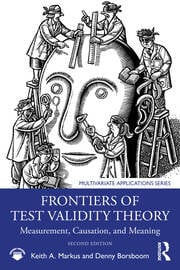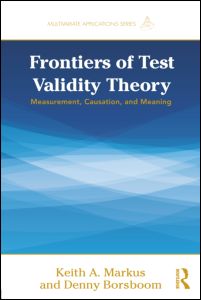
Frontiers of Test Validity Theory: Measurement, Causation and Meaning
Second Edition
Keith A. Markus and Denny Borsboom
2025 Routledge
|
|
|
|---|---|
| Frontiers of
Test Validity Theory (book) |
|
|
|
|
|
|
|
|
|
|
|
|
|
|
|
|
|
|
 |
Frontiers of Test Validity Theory: Measurement, Causation and MeaningSecond Edition Keith A. Markus and Denny Borsboom 2025 Routledge |
Forward by Lisa L. Harlow
1. Introduction: Surveying the Field of Test Validity Theory.
Part I:
2. Philosophical Theories of Measurement.
3. Psychometric Models.
4. Open Issues in Measurement Theory and Psychometrics.
Part II:
5. Test Scores as Samples: Behavior Domain Theory.
6. Causality in Measurement.
7. Causation, Correlation, and Reflective Measurement Models.
8. Problems in Causation and Validity: Formative Measurement,
Networks, and Individual Differences.
Part III:
9. Interpreting Test Responses: Validity, Values, and
Evaluation.
10. A Model of Test Score Interpretation.
11. Open Questions About Test Score Meaning.
Part IV:
12. An Integrative View of Test Validity.
13. Epilogue as Dialog: The Future of Test Validity Theory.
Now in its second edition, this important book examines test validity in the behavioral, social, and educational sciences by exploring three fundamental problems: measurement, causation, and meaning. Psychometric and philosophical perspectives and unresolved issues receive attention, as the authors explore how measurement is conceived from both the classical and modern perspectives.
Split into three accessible sections, the first contrasts theories of measurement as applied to the validity of behavioral science measures, and the second considers causal theories of measurement as well as alternative theories of causation. The final section explores the meaning and interpretation of test scores as they apply to test validity, offering a conceptual overview of the field and its current state. Each carefully revised chapter begins with an overview of key theories and literature, concludes with a list of suggested readings, and features boxes with real-life situations that connect theory to practice. Examples of specific issues include:
Researchers, practitioners, and policy makers interested in test validity or developing tests will appreciate the book's cutting-edge review of test validity. Focusing on both the underlying concepts, as well as practical challenges of test construction and use, it also serves as a supplement in graduate or advanced undergraduate courses on test validity, psychometrics, testing, or measurement taught in psychology, education, sociology, social work, political science, business, criminal justice, and other fields. The book does not assume a background in measurement.
 |
Frontiers of Test Validity Theory:
Measurement, Causation and Meaning
|
 |
1. Introduction: Surveying the Field of Test Validity
Theory.
Part I:
2. Philosophical Theories of Measurement.
3. Psychometric Models.
4. Open Issues in Measurement Theory and Psychometrics.
Part II:
5. Test Scores as Samples: Behavior Domain Theory.
6. Causality in Measurement.
7. Causation, Correlation, and Reflective Measurement
Models.
8. Problems in Causation and Validity: Formative
Measurement, Networks, and Individual Differences.
Part III:
9. Interpreting Test Responses: Validity, Values, and
Evaluation.
10. A Model of Test Score Interpretation.
11. Open Questions About Test Score Meaning.
Part IV:
12. An Integrative View of Test Validity.
13. Epilogue as Dialog: The Future of Test Validity Theory.
This book examines test validity in the behavioral, social, and educational sciences by exploring three fundamental problems: measurement, causation and meaning. Psychometric and philosophical perspectives receive attention along with unresolved issues. The authors explore how measurement is conceived from both the classical and modern perspectives. The importance of understanding the underlying concepts as well as the practical challenges of test construction and use receive emphasis throughout. The book summarizes the current state of the test validity theory field. Necessary background on test theory and statistics is presented as a conceptual overview where needed.
Each chapter begins with an overview of key material reviewed in previous chapters, concludes with a list of suggested readings, and features boxes with examples that connect theory to practice. These examples reflect actual situations that occurred in psychology, education, and other disciplines in the US and around the globe, bringing theory to life. Critical thinking questions related to the boxed material engage and challenge readers. A few examples include:
What is the difference between intelligence and IQ?
Can people disagree on issues of value but agree on issues of test validity?
Is it possible to ask the same question in two different languages?
The first part of the book contrasts theories of measurement as applied to the validity of behavioral science measures.The next part considers causal theories of measurement in relation to alternatives such as behavior domain sampling, and then unpacks the causal approach in terms of alternative theories of causation.The final section explores the meaning and interpretation of test scores as it applies to test validity. Each set of chapters opens with a review of the key theories and literature and concludes with a review of related open questions in test validity theory.
Researchers, practitioners and policy makers interested in test validity or developing tests appreciate the book's cutting edge review of test validity. The book also serves as a supplement in graduate or advanced undergraduate courses on test validity, psychometrics, testing or measurement taught in psychology, education, sociology, social work, political science, business, criminal justice and other fields. The book does not assume a background in measurement.
"[I]s this book worth reading? The answer is a resounding yes for those who are looking to make more sense of generalizability theory, IRT, and SEM applications in a testing/assessment-centered arena, as a user, developer, or both." (p. 2)No Author (2013). Reference & Research Book News, 28(3), 8-12.
"Assuming no previous background in the relevant philosophical areas, they discuss such topics as philosophical theories of measurement, open issues in measurement theory and psychometrics, problems in causation and validity, a model of test score interpretation, and an integrative view of test validity." (p. 8).Heberle, J. F. (2013). Frontiers of test validity theory: measurement, causation and meaning (book review). Choice, 51(4), 51-2153. doi: 10.5860/CHOICE.51-2153
"Highly recommended. Graduate students, faculty, researchers, professionals." (p. 684).Kane, M. T. (2014). Frontiers of test validity theory: measurement, causation, and meaning (book review). Assessment in Education: Principles, Policy & Practice, 21, 238-244. 7p. DOI: 10.1080/0969594X.2013.878684.
"Markus and Borsboom provide thought-provoking analyses of the roles played by measurement, causality and meaning in validity theory." (p. 243).Gotch, C. M, (2014). Frontiers of test validity theory: measurement, causation, and meaning (book review). Journal of Educational Measurement, 51, 463–469.
"Simply put, Frontiers of Test Validity Theory is an essential volume in the library of the measurement professional or advanced graduate student who wants to approach their work with purpose and understanding." (p. 466).


Markus, K. A. (accepted). Construct validity. In T. Teo (Ed.),
Palgrave Encyclopedia of Theoretical and Philosophical
Psychology. London: Palgrave.
Abstract
Construct validity refers to a general approach to test validity
that rests on the assumption that validation is theory-based.
Construct validity is broadly opposed to operational definition in
assuming that the same construct can be assessed fallibly by
various measurement instruments. Initially, construct validity was
seen as one type of validation among others and was rooted in
logical empiricist philosophy of science. More recently, construct
validity has come to be seen as the whole of test validity,
subsuming other types as lines of evidence in support of construct
validity and has become rooted in scientific realism. Recent work
has proposed various modifications of the received view embodied
in the Standards for Educational and Psychological Measurement.
Markus, K. A. (2021). Causal effects and counterfactual
conditionals: contrasting Rubin, Lewis and Pearl. Economics
& Philosophy, 37(3), 441-461. DOI:
https://doi.org/10.1017/S0266267120000437
Abstract
Rubin and Pearl offered approaches to causal effect estimation and
Lewis and Pearl offered theories of counterfactual conditionals.
Arguments offered by Pearl and his collaborators support a weak
form of equivalence such that notation from the rival theory can
be re-purposed to express Pearl’s theory in a way that is
equivalent to Pearl’s theory expressed in its native notation.
Nonetheless, the many fundamental differences between the theories
rule out any stronger form of equivalence. A renewed emphasis on
comparative research can help to guide applications, further
develop each theory, and better understand their relative
strengths and weaknesses.
Markus, K. A. (2020). On epistemic violence in
psychological science. Theory and Psychology, 30,
478-482. doi:
https://doi.org/10.1177/0959354320914968
Markus, K. A. (2019). Review of Measurement Theory and Applications for the Social Sciences. Psychometrika. 84, 646-648. doi: 10.1007/s11336-018-9637-6
Markus, K. A. (2018). Three conceptual impediments to
developing scale theory for formative scales. Methodology,
14, 156-164. doi: 10.1027/1614-2241/a000154
Abstract: Bollen and colleagues have advocated the use of
formative scales despite the fact that formative scales lack an
adequate underlying theory to guide development or validation such
as that which underlies reflective scales. Three conceptual
impediments impede the development of such theory: the
redefinition of measurement restricted to the context of model
fitting, the inscrutable notion of conceptual unity, and a
systematic conflation of item scores with attributes. Setting
aside these impediments opens the door to progress in developing
the needed theory to support formative scale use. A broader
perspective facilitates consideration of standard scale
development concerns as applied to formative scales including
scale development, item analysis, reliability, and item bias.
While formative scales require a different pattern of emphasis,
all five of the traditional sources of validity evidence apply to
formative scales. Responsible use of formative scales requires
greater attention to developing the requisite underlying theory.
Markus, K. A. (2017) Review of Causal Inference in
Statistics: A Primer, by Judea Pearl, Madelyn Glymour, and
Nicholas P. Jewell, Structural Equation Modeling: A
Multidisciplinary Journal, 24, 636-642, DOI:
10.1080/10705511.2017.1299012
Markus, K. A. (2016). Validity bites: comments and
rejoinders. Assessment in Education: Principles, Policy
& Practice, 23, 312-315. doi:
10.1080/0969594X.2016.1156643
Markus, K. A. (2016). Alternative vocabularies in the test
validity literature. Assessment in Education: Principles,
Policy & Practice, 23, 252-267. doi:
10.1080/0969594X.2015.1060191
Abstract: Justification of testing practice involves moving
from one state of knowledge about the test to another. Theories of
test validity can (a) focus on the beginning of the process, (b)
focus on the end or (c) encompass the entire process. Analyses of
four case studies test and illustrate three claims: (a)
restrictions on validity entail a supplement required to obtain
justification from validity. (b) Rationales for restrictions
assume particular contexts. (c) Claims can be translated between
contrasting vocabularies. Implications for consumers of test
validity theory include encouragement to focus on content instead
of form and to write and read mindfully of the multiplicity of
validity vocabularies. Implications for producers of test validity
theory include encouragement to consider multiple reconstructions
of a particular theory of test validity, clearly distinguish
validity theories from validity definitions, and focus on
contributing arguments that constrain possible theories rather
than contributing definitions or broad frameworks.
Markus, K. A. (2016). Consistent treatment of variables
and causation poses a challenge for behavioral research methods:
A commentary on Nesselroade and Molenaar (2016).
Multivariate Behavioral Research, 51, p413-418. doi :
10.1080/00273171.2015.1081089
Markus, K. A. (2015). Roger Ellis Millsap
(1954-2014). American Psycholgist, 70, 931. doi:
10.1037/a0039885
Markus, K. A. (2014). Unfinished Business in Clarifying
Causal Measurement: Commentary on Bainter and Bollen.
Measurement, 12, 146-150. doi :
10.1080/15366367.2014.980106
Markus, K. A. (2014). Theory, observation, and validation:
Commentary on Almond, Kim, Velasquez, & Shute.
Measurement, 12, 47-50. doi : 10.1080/15366367.2014.921033
Markus, K. A. (2013). An incremental approach to causal
inference in the behavioral sciences. Synthese
(online). DOI: 10.1007/s11229-013-0386-x.
Abstract: Causal inference plays a central role in behavioral science. Historically, behavioral science methodologies have typically sought to infer a single causal relation. Each of the major approaches to causal inference in the behavioral sciences follows this pattern. Nonetheless, such approaches sometimes differ in the causal relation that they infer. Incremental causal inference offers an alternative to this conceptualization of causal inference that divides the inference into a series of incremental steps. Different steps infer different causal relations. Incremental causal inference is consistent with both causal pluralism and anti-pluralism. However, anti-pluralism places greater constraints the possible topology of sequential inferences. Arguments against causal inference include questioning consistency with causation as an explanatory principle, charging undue complexity, and questioning the need for it. Arguments in favor of incremental inference include better explanation of diverse causal inferences in behavioral science, tailored causal inference, and more detailed and explicit description of causal inference. Incremental causal inference offers a viable and potentially fruitful alternative to approaches limited to a single causal relation. (Copyright 2013 Springer Science+Business Media Dordrecht)
Markus, K. A., Loveland, J. E., Ha, D. T. & Raghavan, C.
(2013). Publication trends in intimate partner violence:
Bridging the division in qualitative and quantitative
methods. In C. Raghavan & S. J. Cohen (Eds.), Domestic
Violence: Methodologies in Dialog (pp. 233-253). Boston:
Northeastern University Press.
Abstract: Both qualitative and quantitative methods
contribute to research on intimate partner violence (IPV).
In this chapter we first report a tabular review of IPV research,
focusing on the use of qualitative, quantitative, and mixed
methods. We then explore the conceptual basis for
distinguishing between qualitative and quantitative methods and
argue that in at least one important sense, all methods are mixed
methods. (Copyright 2013 Northeastern University)
Borsboom, D. & Markus, K. A. (2013). Truth and
evidence in validity theory. Journal of Educational
Measurement, 50, 109-113.
Abstract: According to Kane (this issue) “the validity of a
proposed interpretation or use depends on how well the evidence
supports the claims being made”. Because truth and evidence are
distinct, this means that the validity of a test score
interpretation could be high even though the interpretation is
false. As an illustration, we discuss the case of phlogiston
measurement as it existed in the 18th century. At face value,
Kane’s theory would seem imply that interpretations of phlogiston
measurement were valid in the 18th century (because the evidence
for them was strong), even though amounts of phlogiston do not
exist and hence cannot be measured. We suggest that this neglects
an important aspect of validity and suggest various ways in which
Kane’s theory could meet this challenge. (Copyright 2013
National Council on Measurement in Education)
Markus, K. A. (2013). Correspondence without
correspondence theory: Comment on Haig and Borsboom.
Theory and Psychology, 23, 806-811.
Abstract: Haig and Borsboom advocate for psychological
science to adopt a correspondence theory of truth. However,
their argument requires a hidden premise that only correspondence
theories of truth bring the benefits that they ascribe to
correspondence. This premise is not plausible and their argument
therefore does not support their recommendation. Additionally,
considerations extraneous to Haig and Borsboom’s argument speak in
favor of considering alternative theories of truth.
(Copyright 2013 Keith A. Markus)
Markus, K. A. (2013). Theories of causality:
From antiquity to the present & The Oxford handbook of
causation [book review]. Structural Equation Modeling, 20,
708-714.
Abstract: These two books hold interest for structural
equation modeling in part because methodological literature often
passes over the task of explaining what is meant by
causation. Losee offers a brief, lively and to-the-point
introduction and overview revolving round three key questions: (a)
what sorts of things serve as causes and effects, (b) what
relation holds between them, and (c) how might one assess a causal
claim. Beebee, Hitchcock & Menzies offer a comprehensive
and up-to-date compendium of chapters introducing and summarizing
various topics in causation. Losee offers an ideal starting
point while Beebee, Hitchcock and Menzies offers a more in-depth
treatment that can be read cover to cover or used as a reference
book. (Copyright 2013 Keith A. Markus)
Kaufman, D., Codding, R. S., Markus, K. A., Tryon, G. S. &
Nagler Kyse, E. (2013). Effects of verbal and written
performance feedback on treatment adherence: Practical
application of two delivery formats. Journal of
Educational and Psychological Consultation, 23, 264-299.
DOI: 10.1080/10474412.2013.845494
Abstract: Verbal and written performance feedback for
improving preschool and kindergarten teachers’ treatment integrity
of behavior plans was compared using a combined multiple-baseline
and multipletreatment design across teacher–student dyads with
order counterbalanced as within-series conditions. Supplemental
generalized least square regression analyses were included to
evaluate significance. Maintenance of treatment integrity
following termination of performance feedback was included and
correspondence between treatment integrity and student behavior
change was examined. Results suggested that both forms of feedback
were effective for improving treatment integrity but that verbal
performance feedback resulted in immediate and sustained
improvements with
moderate to strong correspondence with student behavior
change. (Copyright 2013 Taylor and Francis Group, LLC)
Markus, K. A. & Borsboom, D. (2012). Reflective Measurement
Models, Behavior Domains, and Common Causes. New Ideas in
Psychology, 31, 54-64.
Abstract: Causal theories of measurement view test items as
effects of a common cause. Behavior domain theories view test item
responses as behaviors sampled from a common domain. A domain
score is a composite score over this domain. The question arises
whether latent variables can simultaneously constitute domain
scores and common causes of item scores. One argument to the
contrary holds that behavior domain theory offers more effective
guidance for item construction than a causal theory of
measurement. A second argument appeals to the apparent circularity
of taking a domain score, which is defined in terms of a domain of
behaviors, as a cause of those behaviors. Both arguments require
qualification and behavior domain theory seems to rely on implicit
causal relationships in two respects. Three strategies permit
reconciliation of the two theories: One can take a causal
structure as providing the basis for a homogeneous domain. One can
construct a homogeneous domain and then investigate whether a
causal structure explains the homogeneity. Or, one can take the
domain score as linked to an existing attribute constrained by
indirect measurement. (Copyright 2011 Elsevier Ltd.)
Markus, K. A. (2012). Linear causal modeling with structural
equations [book review]. Structural Equation Modeling, 19,
703-710.
Abstract: This book provides a welcome update and
compilation of Stanley Mulaik's contributions to structural
equation modeling. The book is not organized in a manner
that would make it easy to use in a semester long course, but it
covers a range of important topics not customarily covered in an
introductory course. Coupled with a comprehensive
introductory text, the book provides sufficient background to read
primary literature on structural equation modeling methods.
The book offers a useful presentation of the author's views on
causation in structural equation modeling despite some faulty
arguments directed at alternative perspectives. The book
also sheds new light on the tensions between realist and
empiricist influences in the author's views on objectivity.
The primary audiences for the book will be those with an interest
in philosophy of science issues as they apply to structural
equation modeling, instructors seeking supplementary reading for
courses, and those new to structural equation modeling looking for
an accessible introduction to more advanced topics.
(Copyright 2012 Keith A. Markus)
Markus, K. A. & Borsboom, D. (2012). The cat came back:
Evaluating arguments against psychological measurement. Theory
and Psychology, 22, 452-466.
Abstract: The possibility or impossibility of quantitative
measurement in psychology has important ramifications for the
nature of psychology as a discipline. Trendler’s (2009) argument
for the impossibility of psychological measurement suggests a
general and potentially fruitful strategy for further research on
this question. However, the specific argument offered by Trendler
appears flawed in several respects. It seems to conflate what must
hold true with what one must know and also equivocate on the
necessary evidence. Moreover, if the argument supported its
conclusion, it would rule out qualitative discourse on psychology
as well as psychological measurement. Taking Trendler’s argument
as an example, one can formulate a general structure to arguments
adopting the same basic strategy. An overview of the requirements
that such arguments should meet provides a metatheoretical
perspective that can assist authors in constructing such arguments
and readers in critically evaluating them. (Copyright 2011
the authors)
Markus, K. A. (2012). Constructs and attributes in test
validity: Reflections on Newton's account. Measurement:
Interdisciplinary Research and Perspectives, 10, 84-87.
Absract: Newton provides a thoughtful and valuable
contribution to test validity theory. I question the notion
of an attribute as constrasted with a construct. I question
the strict requirement that a test must measure the attribute
entailed by a decision for which the test is used. I also
question the rejection of degrees of validity. (Copyright
2012 Keith A. Markus)
Markus, K. A. (2012). Principles and practice of structural
equation modeling, 3rd ed. [book review]. Structural
Equation Modeling, 3, 509-512.
Abstract: The third edition of Kline's text offers a
welcome update and restructuring of the text. Much is
improved from the previous version although the strain of
squeezing an adequate introduction to all things SEM into a single
semester course cannot be avoided. The text continues to
provide a highly articulate and accessible introduction, but not
an adequate preparation for the technical literature for most
readers. (Copyrigh 2012 Keith A. Markus)
Markus, K. A. (2012). Mulaik on atomism, contraposition
and causation. Quality and Quantity, 46, 559–571.
Abstract: Causal inference using statistical models plays a
central role in many areas of behavioral science, but the
underlying metatheory of causal explanation remains poorly
developed. Mulaik's work on causation offers a useful foray
into this topic. Evaluation of two negative arguments applied to a
broad range of theories of causation offer overdue critical
assessment of this contribution. More broadly, the critical
evaluation of Mulaik's arguments speak to the need for better
integration of substantive theories and statistical models in
causal research. (Copyright 2010 Springer Science+Business Media
B.V.)
Markus, K. A. (2012). Review of Bias and causation: Models and
judgment for valid comparison. Journal of
Educational and Behavioral Statistics, 37, 475-476.
Abstract: Weisberg offers a useful integrative treatment of
approaches to causal inference across a variety of
disciplines. The book includes useful original thinking
through of key issues in causal inference primarily from a
potential outcomes perspective. However, the book does not
provide a non-circular analysis of causation itself.
(Copyright 2012 Keith A. Markus)
Markus, K. A. (2011). Real causes and ideal manipulations:
Pearl's theory of causal inference from the point of view of
psychological research methods. In P. McKay Illari, F. Russo
& J. Williamson (Eds.), Causality in the sciences (pp.
240-269). Oxford, UK: Oxford University Press.
Abstract: Pearl's work on causation has helped focus new
attention on the nature of causal reasoning and causal inference
in behavioral science. Pearl takes an axiomatic approach,
presenting axioms as first principles, but these may be better
understood at boundary conditions for the application of the
theory. Pearl adopts a non-eliminative but instrumental approach
to causation which creates some tension with the tradition of
ruling out rival hypotheses in the behavioral sciences. Finally,
much causal reasoning in the behavioral sciences involves
reasoning across possible world that differ in their causal
structure, which becomes awkward within the basic architecture of
Pearl's system. A neighborhood semantics approach could represent
this type of reasoning more naturally. Consideration of these
issues may be helpful both to behavioral scientists working to
incorporate Pearl's work and also to those working outside the
behavioral sciences attempting to explain causal reasoning within
those sciences. (Copyright 2011 Oxford University Press)
Markus, K. A. (2010). Structural Equations and Causal
Explanations: Some Challenges for Causal SEM. Structural
Equation Modeling, 17, 654-676.
Abstract: One common application of structural equation modeling
(SEM) involves expressing and empirically investigating causal
explanations. Nonetheless, several aspects of causal explanation
that have an impact on behavioral science methodology remain
poorly understood. It remains unclear whether applications of SEM
should attempt to provide complete explanations or partial
explanations. Moreover, it remains unclear what sorts of things
researchers can best take as causes and effects. Finally, the
meaning of causal assertions itself remains poorly understood.
Attempting to clarify the use of structural equations as causal
explanations by addressing these issues has implications for
behavioral science methodology because applications of SEM
typically remain vague about causation and thus about their
substantive conclusions. Research aimed at clarifying these issues
can lead to a sharper and more refined use of SEM for causal
explanation, and by extension, clarify behavioral science
methodology more generally. (Copyright 2010 Taylor & Francis
Group LLC)
Markus, K. A. (2010). Hunting causes and using them: Approaches
in philosophy and economics [book review]. Structural Equation
Modeling, 17, 535-540.
Abstract: Nancy Cartwright seeks to question the traditional
division of labor between the policy analyst, social or behavioral
science methodologists, and the philosopher, encouraging instead a
closer colaboration between the three. A series of 13 articles
explore various aspects and this central theme. The articles
provide detailed thoughtful probing of a number of important
issues in applied causal inference. Some of these issues reflect
active areas of research and others reflect neglected issues that
warrant greater attention. The collection offers little in terms
of synthesis across the 13 essays, and makes few consessions to
readers lacking prior familiarity with the formal notation used in
examples at various points in the book. Nonetheless, the book
offers a valuable compilation including four new articles that
will be of interest to anyone concerned with issues of causation
and causal inference in the context of public policy and the
research that informs it. (Copyright 2010 Keith A. Markus)
Markus, K. A. (2010). Questions about networks, measurement and
causation. Behavioral and Brain Sciences, 33, 164-165.
Abtract: Cramer et al. present a thoughtful application of
network analysis to symptoms, but certain questions remain open.
These questions involve the intended causal interpretation, the
critique of latent variables, individual variation in causal
networks, Borsboom’s idea of networks as measurement models, and
how well the data support the stability of the network results.
(Copyright 2010 Cambridge University Press)
Markus, K. A. & Lin, J.-Y. (2010). Construct validity. In
N. Salkind (Ed.), Encyclopedia
of research design (pp. 229-233). Thousand Oaks, CA:
Sage Publications.
Abstract: Provides an overview of construct validity as the term
is used in test validity theory.
Markus, K. A. & Smith, K. M. (2010). Content validity. In
N. Salkind (Ed.), Encyclopedia
of research design (pp. 238-243). Thousand Oaks, CA:
Sage Publications.
Abstract: Provides an overview of content validity as the term is
used in test validity theory.
Markus, K. A., Gu, W. (2010). Bubble plots as a model free
graphical tool for continuous variables. In H. D. Vinod (Ed.), Advances in social science
research using R (p. 65-94). New York: Springer.
Abstract: Researchers often wish to understand the relationshp
between two continuous predictors and a common continuous outcome.
Many options for graphing such relationships, including
conditional regression lines or 3D regression surfaces, depend on
an underlying model of the data. The veridicality of the graph
depends upon the veridicality of the model, and poor models can
result in misleading graphs. An enhanced 2D scatterplot or bubble
plot tha reprsents values of a variable using the size of the
plotted circles offers a model-free alternative. The R function
bp3way() implements the bubble plot with a variety ofuser
specifiable parameters. An empirical study demonstrates the
comparability of bubble plots to other model-free plots for
exploroing three-way continuous data. (Copyright 2010 Springer
Science + Business Media)
Markus, K. A., Hawes, S. W., & Thasites, R. J. (2008).
Abductive inferences to psychological variables: Steiger's
question and best explanations of psychopathy. Journal of Clinical Psychology,
64, 1069-1088.
Abstract: Abductive inference often involves inference to the
best explanation. A focus on the bestness of explanations
facilitates a comparative analysis of how abductive inference
would differ if approached with four contasting sets of
assumptions about how scientific inference works: positivism,
realism, and two kinds of pragmatism. As a thought
experiment, one can imagine a situation in which competing
models of psychopathy differ in parsimony and fit to the data, but
produce tie when considering both virtues in combination. The
thought experiment demonstrates that Steiger's (1990) question
about how best to combine competing virtues in scientific
inference applies to abductive inference and that the answers
depend upon other assumptions about how science works. The
comparative analysis helps focus some of the issues that require
clarification before abductive inference can enter the Pantheon of
standard research methods in psychology. More constructively, the
analysis also demonstrates that one need not accept scientific
realism to accept the use of abductive inference. (Copyright 2008
Wiley Periodicals, Inc.)
Markus, K. A. (2008). Putting concepts and constucts into
practice: A reply to Cervone and Caldwell, Haig, Kane, Mislevy,
and Rupp. Measurement, 6,
147-154.
Abstract: The commentary has greatly enriched the discussion initiated by the three target articles. The distinction between constructs and concepts contributes to both the top-down and bottom-up aspects of the dialectic between measurement theory and practice. The distinction also illuminates the abstraction from observation to manifest variables. However, the semantic analysis of variables in terms of ordered pairs of individuals and values of variables does not seek to describe a procedure for defining constructs as part of the test development process. As such, uncertainty about population membership does not pose a pragmatic constraint on the application of the distinction between concepts and constructs. Finally, meaning and reference in the context of test development can best be understood as jointly determined by both how the world is and the nature of the vocabularies chosen to describe it. Thus, both of these factors bear on the definition of specific constructs and concepts measured by individual tests. Distinguishing constructs from concepts can help clarify and advance discourse on testing and measurement across a wide range of domains. (Copyright 2008 Taylor & Francis Group, LLC)
Markus, K. A. (2008). Constructs, concepts and the worlds of
possibility: Connecting the measurement, manipulation, and
meaning of variables. Measurement,
6, 54-77.
Abstract: A theoretical variable such as integrity,
conscientiousness, or academic honesty may correspond to either a
construct or a concept, but the standard idiom does not
distinguish the two. One can describe the difference between
constructs and concepts in terms of set theory. Constructs extend
over actual cases, whereas, concepts extend over both actual and
possible cases. As such, theoretical claims made about, say,
integrity as a construct differ from claims about integrity as a
concept. The restrition of constructs to a specified population
plays a central role in test validation and psychometric analyses
aimed at distinguishing constructs from one another. The extension
of concepts over possible populations plays a central role in the
adoption of nonactual possibilities as goals in making efforts
toward systemic change and also in the comparison of construts
across populations. The failure of the standard idiom, which
conflates constructs with concepts, to provide a vocabulary that
captures both population-dependent and population-independent
aspects of variables recommends the modifiction of that idiom to
distinguish constructs from concepts. This distinction suggests
various changes in practice such as including the intended
population in the names of constructs but not concepts. (Copyright
2008 Taylor & Francis Group, LLC)
Markus, K. A. (2008). Hypothesis formulation, model
interpretation, and model equivalence: Implications of a
mereological causal interpretation of structural equation
models. Multivariate
Behavioral Research, 43, 177-209.
One can distinguish statistical models used in causal modeling
from the causal interpretations that align them with substantive
hypotheses. Causal modeling typically assumes an efficient causal
interpretation of the statistical model. Causal modeling can also
make use of mereological causal interpretations in which the state
of the parts determines the state of the whole. This
interpretation shares several properties with efficient causal
interpretations but also differs in terms of other important
properties. The vailability of alternaive causal interpretations
of the same statistical models has implications for hypothesis
specification, research design, causal inerence, data analysis,
and the interpretation of research results. (Copyright 2008 Taylor
& Francis Group, LLC)
Markus, K. A. (2007). Philosophical foundations of quantitative
research methodology [book review]. Structural Equation Modeling, 14, 527-533.
Abstract: Yu has not written a book that offers significant
contributions to cutting-edge work on the philosophical
underpinnings of quantitative methods, nor has he written a
systematic survey of philosophical foundations of quantitative
methods. Yu has written an accessible and engaging book that
provides and excellent introductory overview for nonspecialists.
Even readers with a background in these issues can appreciate the
book for these latter qualities. (Copyright 2008 Taylor &
Francis Group, LLC)
Markus, K. A. (2007) Making Things Happen by James
Woodward. [book review] Structural Equation Modeling, 14,
170-178.
Abstract: The scholarly community recently lost two luminary
contributors to the causation literature, David Lewis andWesley
Salmon, but the two remain very much present
in this book by James Woodward. Woodward aligns himself with Lewis
in advocating a counterfactual account of causation (explained
later), whereas Salmon
surfaces throughout the book as the representative of
noncounterfactual accounts of causation and the prime target for
criticism. As such, the book holds interest
both as a contribution to the primary literature, by offering a
distinct theory of causal assertion and causal explanation, and
also as a contribution to the secondary
literature, by illuminating the work of Lewis, Salmon, and others.
(Copyright 2008 Taylor & Francis Group, LLC)
Davis, M. & Markus, K. A. (2006). Misleading cues,
misplaced confidence: an analysis of deception detection
patterns. American Journal of Dance Therapy, 28, 107-126.
Abstract: First, a case is made that the processes and
assumptions underlying judgments of whether someone is lying
during a high stakes interview may be similar to movement
interpretation processes in a clinical context, and that the
former is easier to research than the latter. Graduate students
judged the credibility of utterances from actual criminal
confessions, explained their decisions, and rated how confident
they felt in each decision. Four of the items contained a
conventional but invalid nonverbal cue to deception and one
contained two conventional, but incorrect, cues to truth-telling.
Groups of 30 judged either content only transcripts, verbatim
transcripts, audio, or audio/video. Comparison of rationales,
confidence level, and accuracy across modality provided evidence
of which cues misled judges, how nonverbal cues modified verbal
content judgments, and detection patterns that warranted further
research. The implications of the results for movement observation
and interpretation in dance/movement therapy are discussed.
(Copyright 2006 American Dance Therapy Association)
Davis, M., Markus, K. A. & Walters, S. B. (2006). Judging
the Credibility of Criminal Suspect Statements: Does Mode of
Presentation Matter? Journal of Nonverbal Behavior, 30, 181-198.
Abstract: For a study of modality differences in deception
detection accuracy, groups of graduate students judged segments
selected from videotapes of criminal confessions. Twenty brief
utterances were presented in four ways: content only transcript,
verbatim transcript, audio only, and audio/videotape. No modality
difference in unbiased truth hit rate was found, but unbiased lie
hit rate varied by modality, with judges of transcripts stripped
of pause indications, word repeats, and umms and uhhs less
accurate than verbatim transcript judges, audio judges, and
audio/video judges. The 62% overall accuracy and 61% lie detection
accuracy of audio judges was highest and, in contrast to other
judges, audio judgments did not display a response bias. The
results remain consistent with the presence of valid visual cues
but suggest that at least in some situations focus on valid vocal
cues may offer more accuracy. (Copyright 2006 Springer
Science+Business Media, Inc)
Markus, K. A. (2006) Structural Equation Modeling. In S.
G. Rogelberg (Ed.), The Encyclopedia of Industrial and
Organizational Psychology, (pp 773 - 776). Thousand Oaks,
CA: Sage Publications.
Abstract: Introduces basic concepts of SEM. Statistical modeling
concepts include model specification, parameter estimation, model
fit, and model interpretation. Causal modeling with SEM, SEM
resources, and alternatives to SEM are also discussed. (Abstract
Copyright 2006 Keith A. Markus)
Markus, K. A. (2006). Causation and counterfactuals [book
review]. Structural
Equation Modeling, 13, 142-151.
Abstract: Collins, Hall and Paul provide an
outstanding resource for those interested in counterfactual
theories of causation. The introductory essay would be an
ideal supplementary reading in a methodology course. The
book systematically develops current advances and problems in
counterfactual theories of causation. However, someone
looking for a general overview of theories of causation would want
to cast his or her net more widely. (Copyright 2006 Ketih A.
Markus)
Davis, M., Markus, K. A., Walters, S. B., Vorus, N., &
Connors, B. (2005). Behavioral cues to deception vs. topic
incriminating potential in criminal confessions. Law and Human Behavior, 29,
683-704.
Abstract: Coding statements of criminal suspects
facilitated tests of four hypotheses about differences between
behavioral cues to deception and the incriminating potential (IP)
of the topic. Information from criminal investigations
corroborated the veracity of 337 brief utterances from 28
videotaped confessions. A four-point rating of topic IP
measured the degree of potential threat per utterance. Cues
discriminating true vs. false comprised word/phrase repeats,
speech disfluency spikes, nonverbal overdone, and protracted
headshaking. Non-lexical sounds discriminated true vs. false
in the reverse direction. Cues that distinguished IP only
comprised speech speed, gesticulation amount, nonverbal animation
level, soft weak vocal and "I (or we) just" qualifier.
Adding "I don't know" to an answer discriminated both IP and true
vs. false. The results supported hypothesis about
differentiating deception cues from incriminating potential cues
in high-stakes interviews, and suggested that extensive research
on distinctions between stress-related cues and cues to deception
would improve deception detection. (Copyright 2005 American
Psychology-Law Society/Division 41 of the American Psychological
Association)
Markus, K. A. (2005). The Facts of Causation by D.H. Mellor [book review]. Structural Equation Modeling: A Multidisciplinary Journal, 12, 506-512.
Abstract: Mellor provides a readable and
valuable discussion of current issues in the theory of
causation. He argues in favor of facts as causes and
effects. A number of points from his discussion have direct
relevance for causal modeling. (Copyright 2005 Keith A.
Markus)
Markus, K. A. (2004). Varieties of causal
modeling: How optimal research design varies by
explanatory strategy. In K. van Montfort, J.Oud & A.
Satorra (Eds.), Recent
developments on structural equation models: Theory and
applications (pp. 175-196). Dordrecht:
Kluwer Academic Publishers.
Abstract: Structural equation models allow
for interpretation as causal models within a variety of
explanatory strategies. Literal explanatory strategies
locate causation in the process modeled whereas non-literal
strategies locate causation in the theoretical description
itself. Robust strategies apply the model to possible cases
as well as actual cases whereas non-robust strategies
restrict application to actual cases. Crossing these two
basic distinctions yields a fourfold explanatory strategy typology
(FEST). The four explanatory strategies differ in their
implications for research design, including what makes for the
best measures, what form generalization takes, what makes for a
good replication, and what makes for a good extension. The
best choice of explanatory strategy may depend upon the state of
research in a specific topic area. By demonstrating a
many-to-one mapping of substantive interpretations onto
statistical models, the FEST illustrates syntactical equivalence,
an extension of the statistical equivalence concept in which
different substantive models share the same structural equation
model with similar implications for inferences from data to
theory. (Copyright 2004 Keith A. Markus)
Markus, K. A. (2002). Statistical equivalence, semantic equivalence, eliminative induction, and the Raykov-Marcoulides proof of infinite equivalence. Structural Equation Modeling, 9, 503-522.
Abstract: Statistically equivalent models produce the same range of moment matrices over the domain of their parameter spaces. Raykov and Marcoulides (2001) proposed a proof that leads to the conclusion that all structural equation (SE) models with certain minimal components have infinitely many statistically equivalent models. A variation on their proof covers an even broader class of models. This conclusion has important implications for the application of at least one notion of eliminative induction to structural equation modeling (SEM). Normally, assertion of statistical equivalence imply that the models differ in meaning, giving statistical equivalence its interest. Consequently, a particular complex causal structure provides a counterexample to the proposed proof. This counterexample suggests that a successful proof may require more detailed attention to the concept of semantic equivalence as characterized y different substantive implications. A formal account of semantic equivalence rests on translation between SE models and a model-neutral descriptive language. (Copyright 2002 Lawrence Erlbaum Associates, Inc.)
Markus, K. A. (2002). Beyond objectivity and subjectivity. American Psychologist, 57, 68-69.
Abstract: In advocating Bayesian inference as applied to Null Hypothesis Significance Tests, Krueger (2001) took for granted conceptual framework that dichotomizes beliefs as either objective (invariant over observers) or subjective (relative to an observer). Despite having claimed a pragmatic basis for his argument, Krueger overlooked the fact that a more thoroughgoing pragmatic approach would avoid this problematic framework altogether. As a consequence, Krueger drew two unjustified conclusions. He could have avoided these premature conclusions by considering beliefs as grounded in collectively accepted but continuously evolving norms for the justification of knowledge claims. Such a view avoids the false choice between objectivity and subjectivity and thus undermines any inference from the an inability to attain the former to an inability to avoid of the latter. (Copyright 2002 Keith A. Markus.)
Markus, K. A. (2001). The converse inequality argument against tests of statistical significance. Psychological Methods, 6, 147-160.
Abstract: Critics have put forth several arguments against the use of tests of statistical significance (TOSSes). Among these, the converse inequality argument stands out but remains sketchy, as does criticism of it. The argument states that we want P(H|D) (where H and D represent hypothesis and data, respectively), we get P(D|H), and the 2 do not equal one another. Each of the terms in 'P(D|H) =/= P(H|D)' requires clarification. Furthermore, the argument as a whole allows for multiple interpretations. If the argument questions the logic of TOSSes, then defenses of TOSSes fall into 2 distinct types. Clarification and analysis of the argument suggests more moderate conclusions than previously offered by friends and critics of TOSSes. Furthermore, the general method of clarification through formalization may offer a way out of the current impasse. (Copyright 2001 American Psychological Association.)
Fenster, A., Markus, K. A., Wiedemann, C. F., Brackett, M. A. & Fernandez, J. (2001). Selecting tomorrow's forensic psychologists: A fresh look at some familiar predictors. Educational and Psychological Measurement, 61, 336-348.
Abstract: The present study examined the use of the Graduate Record Examination (GRE-Verbal and GRE-Quantitative) and undergraduate grade point average (UGPA) to predict long-term performance in an MA program in forensic psychology. The criterion measures were graduate grade point average (GGPA) and time to completion (TTC). Data were available for 206 graduates. Regression analysis indicated that a linear combination of GRE-V and GRE-Q, and UGPA correlated 0.63 with GGPA. Predictive efficiency was reduced by only 2% of the variance when GRE subscores are combined into a total score. The correlation with TTC was smaller (R = 0.31) but nonetheless translated into meaningful differences in student performance. Most noteworthy, GRE scores and UGPA appear to predict better for forensic psychology than for social sciences in general. (Copyright 2001 Sage Publications, Inc.)
Brandt, D. E & Markus, K. A. (2000). Adolescent attitudes towards the police: a new generation. Journal of Police and Criminal Psychology, 15, 10-16.
Abstract: The attitudes toward the police (ATP) of a group of young inner city adolescents were investigated within the context of a program designed to teach dispute resolution skills and promote a dialogue with local police. ATP were measured using a 23 item questionnaire. The results indicated that while ATP were generally positive, girls held more positive ATP than boys and adolescents who reported negative experiences with the police had less favorable ATP. A confirmatory factor analysis of the questionnaire yielded three factors: attitudes toward police behavior, attitudes toward interaction with the police, and attitudes toward interaction with other adults. The results are in general agreement with earlier studies with other populations and have implications for programs designed to improve adolescent relationships with the police. (Copyright 2000 Society of Police and Criminal Psychology.)
Markus, K. A. (2000). Twelve testable assertions about cultural dynamics and the reproduction of organizational culture. In N. M. Ashkanasy, C. P. M. Wilderom & M. F. Peterson (Eds.), Handbook of organizational culture and climate (pp. 297-308). Thousand Oaks, CA: Sage.
Abstract: The traditional static view of organizational culture (OC) takes the persistence of OC for granted and seeks to explain culture change. Through this chapter I seek to engage the reader in a different kind of conversation about OC: a dynamic view that takes change as primary and seeks to use dynamic processes to explain the persistence of OC over time. Three types of processes occurring in organizations offer potential explanations of the day to day reproduction of OC. Intentional processes involve meanings consciously projected from individual minds into their environment. Unconscious processes involve meanings projected from individual minds, but done so without conscious awareness. Discursive processes involve meanings that take shape in the communicative actions that connect individual minds and that may never have been conscious to any member of the organization practicing the culture. Finally, to put discourse theory to good use we must remain mindful that discursive processes are material processes. (Copyright 2000 Keith A. Markus.)
Markus, K. A. (2000). Conceptual shell games in the four-step debate. Structural Equation Modeling, 7, 163-173.
Abstract: The exchange between Hayduk
and Glaser (2000) and Mulaik and Millsap (2000) sheds new light on
the use of multistep procedures for testing structural equation
models. Nonetheless, the fundamental concepts of the
discussion remain murky. The notion of a correct number of
constructs (interpreted latent variables) rests on a conflation of
the model with the reality it models. The articulation of
what is tested in terms of model constraints encounters as
analogous difficulty. Finally, the appeal to analysis into
clear and distinct ideas holds the potential to clarify some of
these issues, but still awaits the necessary exposition and
application to structural equation modeling. A common thread
shows itself in an over-reliance on single languages of
description. This calls for greater attention to the active
engagement of multiple languages of description. (Copyright
2000 Lawrence Erlbaum Associates, Inc.)
Markus, K. A. (1998). Science, measurement, and validity: Is completion of Samuel Messick's synthesis possible? Social Indicators Research, 45, 7-34.
Abstract: Messick's (1989) theory of
test validity is profoundly influential (Hubley and Zumbo, 1996;
Angoff, 1988) in part because it brings together disparate
contributions into a unified framework for building validity
arguments. At the heart of Messick's theory lies a synthesis
of realism and constructivism with respect to both scientific
facts and measurement. Within this synthesis there remains a
tension between the evidential basis and the consequential basis
for test interpretation and use. This cannot be sidestepped
simply by limiting the evidential basis to test interpretation and
the consequential basis to test use: Interpretation and use
are not so easily held separate. The roles of constructivism
and context in Messick's theory underline the inherent link
between facts and values, but the assumption that facts are
objective and values are subjective goes unquestioned in Messick's
theory. The inherent link between facts and values combines
with this assumption to produce the unresolved tension in
Messick's theory. This suggests that a unified theory of
test validity requires a theory of value justification.
(Copyright 1998 Kluwer Academic Publishers.)
Markus, K. A. (1998). Validity, facts, and values sans closure: Reply to Messick, Reckase, Moss, and Zimmerman. Social Indicators Research, 45, 73-82.
Abstract: Three intertwined issues
are woven through the comments on Markus (1998).
The commentators disagree regarding the idea of a
unitary validity for a given test interpretation. A
similar issue arises regarding a unified concept of test
validity. The third involves the possibility of a
unified validity theory, a theory without internal
tensions. In suggesting that facts differ from values,
but perhaps not in the way typically envisioned, I am also
caught between commentators pulling me in opposing
directions. Additional arguments support the moderate
position taken in the target article. Among my
concessions, however, I recognize that the target article
misleadingly aligned a unified validity theory with closure in
the discussion of test validity. (Copyright 1998 Keith
A. Markus.)
Markus, K. A. (1998). Psychological processes and mental states. American Psychologist, 53, 1077-1078.
Abstract: Kipnis (1997) offers two
arguments against the use of psychological processes as a
basis for the explanation of social behavior. First,
psychological processes cannot be directly measured.
Second, "scientific explanation of behavior should be anchored
in societal events" (p. 208). Kipnis's arguments
conflate psychological processes with mental states.
Discursive Psychology provides a conceptualization of
psychological processes and interpersonal processes rather
than intrapersonal mental states. Kipnis's arguments
against mental states do not apply to this conceptualization
of psychological processes. (Copyright 1998 Keith A.
Markus.)
Markus, K. A. (1998). Judging Rules. The Journal of Experimental Education, 66, 261-265.
Abstract: With the help of some
familiar interlocutors, I have come to see that Marsh and Hau
(1996) is open to more than one reading. On my reading,
the assertion that we have to use judgment in assessing model
fit, as opposed to simply following rules, is an important
theme of the article. This theme is a familiar
refrain. Nevertheless, my several attempts to formulate
the theme are open to criticism. Judgment presupposes
rules rather than being opposed to the following of
rules. Refining our rules in what the game is all
about. Anyone for croquet? (Copyright 1998 Helen
Dwight Reid Educational Foundation.)
Rice, R. W., Markus, K., Moyer, R. P., & McFarlin, D. B., (1991). Tests of Locke's range of affect hypothesis. Journal of Applied Social Psychology, 24, 1977-1987.
Abstract: Two 2 X 2 (Facet Importance X Facet Amount) factorial experiments tested Locke's (1969, 1976) hypothesis that facet importance moderates the range of affective reactions. Written excerpts from letters, interview transcripts, and employee handbooks were used to create scenarios which manipulated the importance and current amount of two target job facets: freedom to do things one's own way on the job, and amount of face-to-face contact with customers/clients. As predicted, significant Facet Importance X Facet Amount interactions showed that facet satisfaction was influenced more strongly by differences in facet amount when the facet was high in importance than when it was low in importance. Subjects in the high-importance condition, relative to subjects in the low-importance condition, were more satisfied with high facet amounts and more dissatisfied with low facet amounts. Discussion focused on the convergence of results from research using different methods to test the range of affect hypothesis. (Copyright 1991 V. H. Winston & Son, Inc.)


Markus, K. A. (2025). Four takes on construct validity. Invited Address, International Meeting of the Psychometric Society, July 18, Minneapolis, MN.
Markus, K. A. (2011). Parallelism,
ergodicity, and psychological explanations.
International Meeting of the Psychometric Society. 20
July 2011. Hong Kong.
Markus, K. A. (2011). State of the Art Talk: Test validity: Looking back and looking forward. International Meeting of the Psychometric Society. 19 July 2011. Hong Kong.
Markus, K. A. (2011). Score interpretations: The
Goldilocks Model. International Meeting of the
Psychometric Society. 19 July 2011. Hong Kong.
Markus, K. A. (2010). Measurement, causation and test
validity: Theoretical puzzles and practical problems.
Lehman College, CUNY. October 4, 2010. Bronx, NY.
Markus, K. A. (2010). Measurement, causation, and test
validity: Theoretical puzzles and practical problems.
Fordham University. September 22, 2010. Bronx, NY.
Markus, K. A. (2010). Measurement, causation, and test
validity: Theoretical puzzles and practical problems.
Doctoral program in social personality, CUNY Graduate
Center. September 15, 2010. Manhattan, NY.
Markus, K. A. (2010). Behavioral science research
ethics: Tensions between individual good and common
good. Paper presented to Societies in transition:
Balancing security, social justice, and tradition
conference, June 4 2010 as part of a symposium
entitled "Ethics in criminal justice research:
Balancing needs for research with ethical
responsibilities" organized by Martin Wallenstein.
Marakech, Morocco.
Markus, K. A. (2009). All methods are mixed methods.
Paper presented to the convention of the American
Psychological Association, August 8, 2009, as part of
a session entitled "Role of Mixed Methods in
Psychological Research" and organized by Gwyneth M.
Boodoo. Toronto, CA.
Markus, K. A. (2009). How can validity come in
degrees? Paper presented at the 2009 International
Meeting of the Psychometric Society. 21 July 2009,
Cambridge, UK.
Markus, K. A. & Gu, W. (2009). Bubble plots as a
model-free graphical tool for three continuous
variables and a flexible R function to plot them.
Conference on quantitative social science research
using R. 18 June 2009, Fordham University, New York.
Markus, K. A., Hawes, S. W. & Thasites, R. J.
(2008, August 16). Abductive Inferences to
Psychological Variables: Weighting Competing Criteria.
Poster presented to the Convention of the American
Psychological Association, Boston MA.
Markus, K. A. (2008, July 30). Construct validity and
causal modeling. Invited paper presented to the
Psychology Department, University of Canterbury,
Christchurch, NZ.
Hawes, S. W. & Markus, K. A. (August, 2007).
Evaluating the Construct Validity of the PCL-R. Poster
accepted to the 115th Annual Conference of the
American Psychological Association. San Francisco, CA.
Chajewski, M. & Markus, K. A. (August, 2007).
Biases in social influence reporting: Social
desirability as deception. Poster accepted to the
115th Annual Conference of the American Psychological
Association. San Francisco, CA.
Chajewski, M., & Markus, K. A. (June, 2007). The
psychometric evaluation of the Sexual Offender Need
Assessment Rating-Self Report (SONAR-SR). Paper
accepted to the 68th Canadian Psychological
Association Annual Convention. Ottowa, CA.
Chajewski, M. & Markus, Keith A. (March, 2007).
Detecting effects of social desirability in the Sexual
Offender Need Assessment Rating-Self Report
(SONAR-SR). Poster presented to the Eastern
Psychological Association Conference. Philadelphia,
PA.
Markus, K. A. & Perillo, A. D. (2007, March).
Judges as Psycho-technocrats: Three Challenges Facing
Fondacaro’s Ecological Jurisprudence. Paper presented
as part of the symposium entitled Comments on
Fondacaro’s Ecological Jurisprudence to the conference
entitled Off The Witness Stand: Using Psychology in
the Practice of Justice. New York, NY.
Markus, K. A. (2007, August). Using Longitudinal Data
to Distinguish Distinct Causal Explanations. Poster
accepted for presentation to the Convention of the
American Psychological Association. San Francisco, CA.
Markus, K. A. (2007, July). A Thrice Parameterized
Tale: Interpreting Quadratic Models. Paper presented
to the 2007 International Meeting of the Psychometric
Society. Tokyo, Japan.
Markus, K. A. (2006, November 2). Cautions on casual
causal analysis: The perspective of causal pluralism.
(Inaugural lecture in the Fordham Council on Applied
Psychometrics Brown Bag Lunch Lecture Series, New
York, NY).
Markus. K. A. (2006, July 9). Causation,
Generalization and Deductive Strength: A
Discussion of Stephen G. West’s "Rubin's and
Campbell's perspectives on causality." Invited
symposium on Causality in Experiments and
Quasi-Experiments. Jena, Germany.
Chajewski, M., & Markus, K. (November,
2006). A self-report version of the Sexual Offender
Need Assessment Rating (SONAR). Paper presented to the
2006 American Society of Criminology Conference. Los
Angeles, CA.
Daftary, T., Kirschner, S., Markus, K. A., Broadwater,
A. (2006). Mock Juror Verdict Selections: Effect
of Media and the Guilty but Mentally Ill Verdict
Option. (Paper accepted for Presentation at American
Society of Criminology Conference, Los Angles, CA).
Markus, K. A. (2006, August 10). Two Fallacies
About Causation: Atomism and
Contraposition. Poster presented at the 114
Annual Convention of the American Psychological
Association. New Orleans, LA.
Markus, K. A. (2006, August 10). Participant in
Statistical Consulting Workshop at the 114 Annual
Convention of the American Psychological
Association. New Orleans, LA.
Markus. K. A. (2006, July 9). Causation,
Generalization and Deductive Strength: A
Discussion of Stephen G. West’s "Rubin's and
Campbell's perspectives on causality." Invited
symposium on Causality in Experiments and
Quasi-Experiments. Jena, Germany.
Markus, K. A. (2006, June 15). Causation de novo
versus causation in sequence: Implications for
potential-response theory applied to linear causal
models. Paper presented at the 2006
International Meeting of the Psychometric
Society. Montreal, CA.
Markus, K. A., Sothmann, F. C., & Raghavan, C.
(2006, March 3). Kinds of Intimate Partner
Violence: Applying Latent Class Analysis to the
Revised Conflict Tactics Scale. Paper presented
to the American Psychology and Law Society.
Markus, K. A. (2005, July 13). Distinguishing
constructs from concepts: A semantic
approach. University of Amsterdam,
invited address.
Markus, K. A. (2005, July 8). Concepts, constructs and
Psychological Measurement. Paper
presented at the 2005 International Meeting of the
Psychometric Society.
Markus, K. A. (2005, August 20). Profile plots for
clustered data: multiple error bars.
Poster presented to the 113 Annual Convention of the
American Psychological Association.
Markus, K. A. (2004, July 30). The case for pluralism
about causation. Paper
presented to the 112 Annual Convention of the American
Psychological Association as part of a symposium
entitled Understanding and modeling
causation organized by Bruce Brown.
Markus, K. A. &
Davis, M. (2004, May 3). Toward a typology of
deception: deception rates for response
types. John
Jay College of Criminal Justice, CUNY.
New York, NY.
Markus, K. A. (2003, August 7). Varieties of causal modeling: How explanatory strategy affects research design. Poster presented to the 111th Annual Convention of the American Psychological Association, Toronto, CA.
Markus, K. A. (2002, December 9). Varieties of causal modeling: How explanatory strategy affects research design. Paper presented to the Doctoral Program in Psychology, Industrial and Organizational Subprogram, Baruch College, CUNY. New York, NY.
Markus, K. A, Davis, M. & Walters, S. B. (2002, August 23). Toward a psychological typology of deception: latent class cluster analysis. Poster presented to the 110th Annual Convention of the American Psychological Association, Chicago, IL.
Markus, K. A. (2002, June 23). Semantically Equivalent Structural Equation Models: Definition, Examples, and Theoretical Significance. North American Meeting of the Psychometric Society, Chapel Hill, NC.
Markus, K. A. (2002, April, 18). A formal-causal interpretation of structural equation models. Expanded paper presented to the Doctoral Program in Educational Psychology, CUNY Graduate Center. New York, NY.
Fenster, A., Markus, K. A., & Palmer, J. (2002, January 4). Predicting diagnositc skills from measures of academic knowledge of psychopathology. Poster presented to the 24th Annual Conference of the National Institute on the Teaching of Psychology, St. Petersburg Beach, FL.
Markus, K. A. (2001, August 27). Activity theories of causality and latent causes. Poster presented to the 109th Annual Convention of the American Psychological Association, San Francisco, CA.
Markus, K. A. (2001, July 16). A formal-causal interpretation of structural equation models. Paper presented to the International Meeting of the Psychometric Society, Osaka, Japan.
Markus, K. A. (2001, June 22). Eliminative Induction and The Raykov-Marcoulides Proof of Infinite Equivalence. Paper presented to the North American Meeting of the Psychometric Society, Valley Forge, PA.
Markus, K. A. (2000, August 4). Defeasibility and degrees of support in tests of statistical significance. Poster presented to the 108th Annual Convention of the American Psychological Association, Washington DC.
Davis, M., Walters, S. B., Vorus, N., Meiland, P. A., & Markus, K. A. (2000, August 4). Verbal and nonverbal cues to false testimony in criminal investigations. Poster presented to the 108th Annual Convention of the American Psychological Association, Washington DC.
Markus, K. A. (2000, July 6). Making true assertions from false models: Addressing a central paradox in structural equation modeling. Paper presented at the 2000 Annual Meeting of the Psychometric Society. Vancouver, British Columbia.
Brandt, D. E. & Markus, K. A. (2000, March 25). An examination of adolescent attitudes towards the police: A new generation. Paper presented to the Annual Conference of the Eastern Psychological Association, Baltimore, MD.
Markus, K. A. (1999, August 23). Concepts versus constructs in theories of integrity. Paper presented to the 107th Annual Convention of the American Psychological Association, Boston, MA.
Markus, K. A. (1999, August 21). Introduction to the NHST problem. Paper presented to the 107th Annual Convention of the American Psychological Association, Boston, MA.
Markus, K. A., Fenster, A., Wiedemann, C. F., Brackett, M. A., & Fernandez, J. (1999, August 20). Selecting tomorrow's forensic psychologists: GRE-V, GRE-Q, and undergraduate GPA. Poster presented to the 107th Annual Convention of the American Psychological Association, Boston, MA.
Markus, K. A. (1999, June 25). Compare and contrast Pearl and Markus on the semantics of structural equation models. Paper presented at the 1999 Annual Meeting of the Psychometric Society, Lawrence, Kansas.
Markus, K. A. (1999, March 23). The new Standards for Educational and Psychological Testing. Presentation sponsored by Forensic Psychology MA program at John Jay College of Criminal Justice, New York, NY.
Markus, K. A. (1998, August 14). Science, measurement, and validity: Is completion of Messick's synthesis possible? Poster presented to the 106th Annual Convention of the American Psychological Association, San Francisco, CA.
Markus, K. A. (1998, August 16). Discussant for Innovations in program and test evaluation. Paper session during the 106th Annual Convention of the American Psychological Association, San Francisco, CA.
Markus, K. A. (1998, June 19). Fit functions as selection functions: Toward a Possible-World Semantics of Structural Equation Modeling. Paper presented at the 1998 Joint Annual Meeting of the Classification Society of North America and the Psychometric Society, Urbana, Illinois.
Markus, K. A. (1997, August 18). The converse inequality argument against tests of statistical significance. Poster presented at 105th Annual Convention of the American Psychological Association, Chicago, IL.
Markus, K. A. (1997, May 31). Discursive processes in organizational membership. Paper presented at The Fifth A. F. Jacobson Symposium in Communications. Omaha, NA.
Markus, K. A. (1996, May 23). Is Measurement Invariance sufficient evidence of invariance in measurement? Pace University, Department of Psychology, New York, NY.
Markus, K. A. (1993, November 11). Comment: Framing self and other in deconstructive versus dialogic reading. New School for Social Research, Taiwan Study Group, New York, NY.
Markus, K. A. (1993, March 24). Subject, culture, text. New School for Social Research, Taiwan Study Group, New York, NY.
Markus, K. A. (1992, October 16). The distinctiveness of the Facet Importance and Wanted Amount job satisfaction constructs. Baruch College, Organization and Policy Studies/Industrial and Organizational Psychology Student Research Conference, New York, NY.
Rice, R.W., Markus, K., Moyer, R.P. & McFarlin, D.B. (1990, April). Tests of Locke's range of affect hypothesis. Poster presented at the annual meeting of the Society for Industrial and Organizational Psychology, Miami, FL.
Markus, K. (1988, May 7). Concepts of causality and their implications for the theory and practice of psychological science. Sixteenth Annual Hunter College Psychology Convention, New York, NY.
Markus, K., Rice, R.W., & McFarlin, D.B. (1988, April 22). Causal relations among the determinants of Facet Satisfaction. Poster presented at the annual meeting of the Eastern Psychological Association, Buffalo, NY.


Psychology
Department
John Jay College
for Criminal Justice
The City
University of New York
524 West 59th
Street
New York, NY 10019
Phone: (212) 237-8784
Fax: (212) 237-8742
Address reprint requests to either tha email or paper mail address. Due to the American Psychology Association's position on electronic publication, I do not make papers downloadable through this web site. If you copy an abstract, please retain the copyright information.


I am currently a member of the Psychology Department at John Jay College of Criminal Justice. I also serve on the graduate faculty of the CUNY Graduate Center in both the Industrial and Organizational Psychology and Forensic Psychology subprograms within the Psychology Doctoral Program, in the Quantitative Psychology subprogram of the Educational Psychology Doctoral Program, and also in the Criminal Justice Doctoral Program. I teach or have taught research methods and quantitative methods courses at the undergraduate, masters and doctoral levels and my syllabi are available on this web page. I completed my Ph.D. in Industrial and Organizational Psychology from The City University of New York in January 1996. I have previously taught Cognitive Psychology and Theories of Motivation at Baruch College.
My methodological
interests include test validity, causation, structural
equation
modeling, latent class analysis, discourse
analysis, psychometrics and test development, program
evaluation, research design, and the logic of
statistical significance testing. My
methodological interests center around the
justification of inferences drawn from social science
research.
My substantive
research interests include intimate partner
violence/domestic violence (IPV/DV), deception
detection, and discourse processes in organizations as
they relate to organizational socialization,
organizational culture, organizational membership,
organizational communication, and other aspects of
organization. I also have an interest in the
logic of conditionals that informs my methodological
work on causal inference, statistical inference, and
test validation.
I belong to The American Psychological Association, The Academy of Management, The Society for Industrial and Organizational Psychology, The Society for Philosophy and Psychology, American Educational Research Association., Psychometric Society, National Council on Measurement in Education, American Evaluation Association, and the Philosophy of Science Association.




I have largely curtailed my consulting activities. If you need a structural equation modeling consultant or a test construction consultant, please email me with a description of the project, you needs, and the estimated time frame.